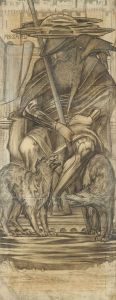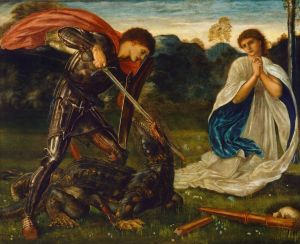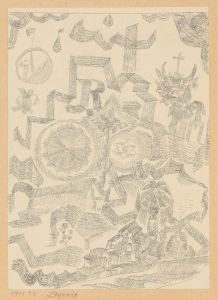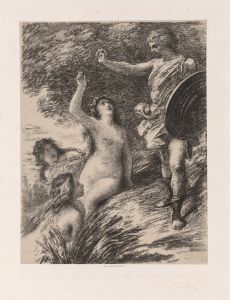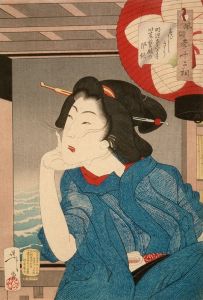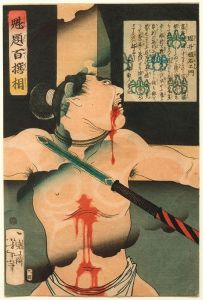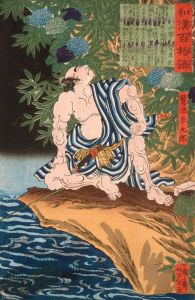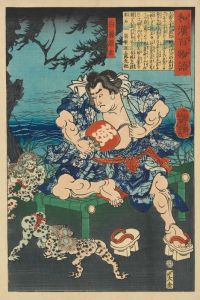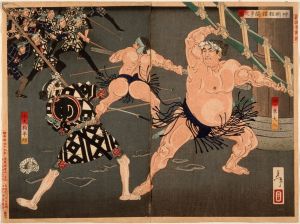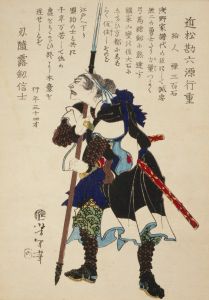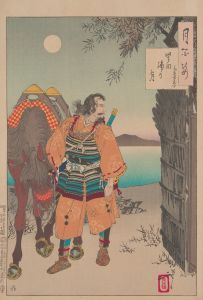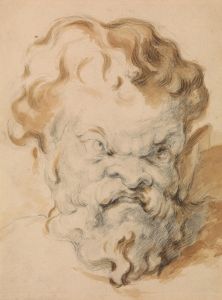
Ushiwakamaru at Gojō Bridge
A hand-painted replica of Tsukioka Yoshitoshi’s masterpiece Ushiwakamaru at Gojō Bridge, meticulously crafted by professional artists to capture the true essence of the original. Each piece is created with museum-quality canvas and rare mineral pigments, carefully painted by experienced artists with delicate brushstrokes and rich, layered colors to perfectly recreate the texture of the original artwork. Unlike machine-printed reproductions, this hand-painted version brings the painting to life, infused with the artist’s emotions and skill in every stroke. Whether for personal collection or home decoration, it instantly elevates the artistic atmosphere of any space.
"Ushiwakamaru at Gojō Bridge" is a renowned woodblock print by the celebrated Japanese artist Tsukioka Yoshitoshi, who was active during the late Edo and early Meiji periods. Yoshitoshi is often regarded as one of the last great masters of the ukiyo-e genre of woodblock printing and painting. His works are noted for their dynamic composition, vivid use of color, and innovative approach to traditional themes.
This particular print depicts a famous scene from Japanese folklore involving the legendary warrior Minamoto no Yoshitsune, who is often referred to by his childhood name, Ushiwakamaru. The scene takes place at Gojō Bridge in Kyoto, a location steeped in historical and cultural significance. According to legend, it was here that Ushiwakamaru, a young and agile warrior, encountered the formidable warrior monk Benkei.
The story goes that Benkei, who was on a mission to collect 1,000 swords by defeating passing samurai, had already collected 999 swords and was waiting for his final opponent. Ushiwakamaru, despite his youth and smaller stature, was able to outmaneuver Benkei with his superior agility and skill. The encounter at Gojō Bridge is a celebrated tale of cleverness and martial prowess, and it marks the beginning of a deep and loyal friendship between the two warriors, with Benkei eventually becoming one of Yoshitsune's most devoted retainers.
Yoshitoshi's depiction of this legendary encounter captures the drama and intensity of the moment. The composition is dynamic, with a strong sense of movement as Ushiwakamaru leaps gracefully to avoid Benkei's attack. The use of bold lines and vibrant colors is characteristic of Yoshitoshi's style, and it serves to highlight the tension and excitement of the scene. The background of the print often features the bridge and the surrounding landscape, adding depth and context to the encounter.
This print is part of Yoshitoshi's series "One Hundred Aspects of the Moon" (Tsuki hyakushi), which was published between 1885 and 1892. The series is considered one of Yoshitoshi's masterpieces and reflects his fascination with historical and mythical subjects, often incorporating elements of the supernatural or the fantastical. Each print in the series is connected to the moon, either through its imagery or its thematic content, and they collectively showcase Yoshitoshi's artistic range and his ability to blend traditional Japanese themes with innovative artistic techniques.
"Ushiwakamaru at Gojō Bridge" exemplifies Yoshitoshi's ability to bring legendary tales to life through his art, capturing the imagination of viewers with his detailed and expressive style. The print remains a significant example of late 19th-century Japanese woodblock printing and continues to be appreciated for its artistic and cultural value.






